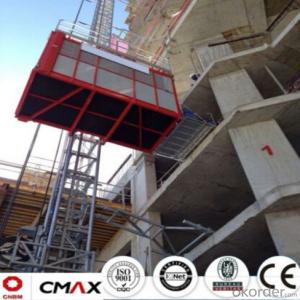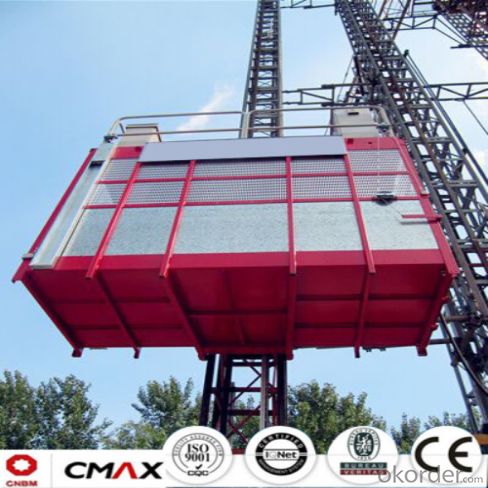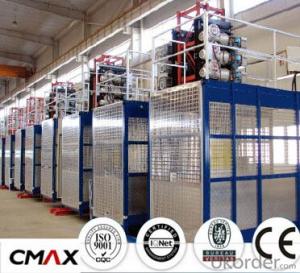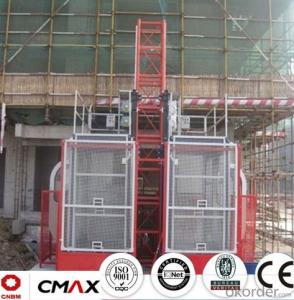Building Hoist Hot Galvanizing Mast Section Spare Parts with 4ton Capacity
- Loading Port:
- China main port
- Payment Terms:
- TT OR LC
- Min Order Qty:
- 1 unit
- Supply Capability:
- 5 unit/month
OKorder Service Pledge
OKorder Financial Service
You Might Also Like
Structure of Building Hoist Description
1.The gearing select perfect bearing,strong cables and oil seal.
2.The electrical parts select products from famous world manufacturers for example Schneider,Siemens and LG.
3.The racks and pinion select advanced material and advanced technique,which enhance the life of all parts.
4.The steel structure adopted strong steel from famous native manufacturers.
5.The surface of the steel structure can adopt paint-spray,parkerizing baking finish or hot galvanizing processing depending on users requirement.
6.The cage can be made and decorated by aluminum molded board,punched-plate or figured aluminum board.
Packaging & Delivery of Building Hoist
Packaging: nude and wooded box Delivery: 25-30days
Mains Parts of Building Hoist
1.The steel structure for example the mast, tie in and cabin ,could be all spay-painted and hot galvanized. Mast section is made with high quality Q345B which is the top standared in China.
2.Electrical parts are all adopted with Schneider , Siemens and other famous brands.
3.The electrical system can be selected with the normal control method and VVVF+PLC control way. Inverter we selected is from Schneider. Yaskawa or other world renowned brand.
4.Cabin exit door select ramping type. The ramping door looks like a bridge between the construction hoist and construction building.
5.The cabin floor is made from 3MM thickness steel riffled board(Hot dip galvanized), and 15MM thickness wooden board which can reduce the vibration and deformation a lot.
6.Driving unit is adopted the products from ZHANGJIANG and other reputed maker, or from SEW, NORD.
7.Safety system is mainly composed of electrical motor braking, anti-drop safety device, top & bottom limit switches, top & bottom 3-phase switches, door limit switches, buffer device and over-load protection. The system aims to ensure the hoist are running safely.
8.Qualification: CE, ISO9001:2008 and etc.
9.The long-term operation of CMAX building hoists testifies CMAX hoist is working performance is stable.
Building Hoist Images



Building Hoist Specification

FAQ of Building Hosit
Q: What is the building hoist main purpose?
A: Building hoist equipped with double or single cabin to transport the materials and labors up and down. It's the ideal construction equipment for vertical transportation in the field of construction.
Q: What is the main structure of building hoist?
A: The P/M construction hoist mainly contains metal structure, driving system, electrical control system, cable guide & protection system, electrical top crane and safety device.
Q: What is the meaning of the building hoist’s code?
A: Take SC200/200 for example: “SC” stands for rack and pinion hoist, “200/200” stands for double cage and capacity is 2 tons per cage. “SC200” stands for single cage and capacity is 2 tons.
Q: What is the dimension of the cage?
A: Normally the cage dimension is 3X1.5X2.5M (L/W/H) for 2t type hoist. Details should be checked according to our
quotation sheet. Also, the size can be customized according to the factual site condition. There are two doors (entrance& exit doors) for each cage, It can be produced as up & down sliding or ramping model for safety and convenience.
- Q: The construction elevator can not operate during the use of several stages of wind power
- Well, there are no definite rules. It's up to you to decide whether to use it or not
- Q: This question asks for the cost associated with purchasing and installing a building hoist.
- <p>The cost of buying and installing a building hoist can vary significantly depending on several factors. The type and capacity of the hoist, the height of the building, and the complexity of the installation are key determinants. On average, the cost can range from $10,000 to $50,000 for the hoist itself, with installation costs potentially adding another 20-50% to the total. However, for very tall buildings or specialized hoists, the price can exceed $100,000. It's crucial to obtain quotes from multiple suppliers and installers to get an accurate estimate for your specific project.</p>
- Q: This question asks for examples of typical uses for building hoists, which are devices used to lift materials in construction settings.
- <p>Building hoists are commonly used in various construction applications. They are utilized for lifting and lowering materials and personnel in high-rise construction projects. Some examples include: 1) Lifting building materials such as bricks, cement, and steel beams to different floors of a building under construction. 2) Transporting workers to elevated work areas for tasks like scaffolding assembly or window installation. 3) Moving heavy equipment to upper levels of a structure. 4) Assisting in the installation of large fixtures like HVAC systems or electrical wiring systems. 5) Facilitating the removal of construction waste from upper floors. These applications highlight the versatility and efficiency of building hoists in construction projects.</p>
- Q: Are there any good signs in the construction elevator door
- It is forbidden to climb, construction lift operation procedure, limited number of passengers, no power cuts
- Q: This question asks for guidance on selecting an appropriate building hoist, which is a type of lifting equipment used in construction.
- <p>Choosing a suitable building hoist involves considering several factors. First, assess the lifting capacity needed based on the weight of materials to be moved. Consider the hoist's speed and lifting height to ensure it meets project requirements. Evaluate the safety features, such as overload protection and emergency stop mechanisms. Check the hoist's durability and maintenance needs, as well as its compatibility with the building's structure. Consult with hoist manufacturers or rental companies for recommendations tailored to your specific project. Always prioritize safety and ensure the hoist complies with local regulations and standards.</p>
- Q: This question asks if a building hoist is capable of lifting objects that vary in size and weight.
- <p>Yes, a building hoist can be used to lift objects of different sizes and weights, but it is crucial to ensure that the hoist's capacity is suitable for the load. Building hoists are designed to handle various materials and equipment during construction, and their lifting capacity can range from a few hundred pounds to several tons. It is essential to check the hoist's specifications and adhere to the maximum load limit to ensure safety and prevent damage to the hoist or the objects being lifted. Always follow the manufacturer's guidelines and safety standards when operating a building hoist.</p>
- Q: When does the construction elevator take off?
- Generally in roof waterproof thermal insulation engineering, interior decoration engineering basic completion, outdoor decoration project is approaching to the end, began to dismantle scaffold outside of time.
- Q: Is it permissible to use personal manual equipment for lifting objects instead of a construction hoist?
- <p>While it might be tempting to use your own manual equipment for lifting objects, it's generally not recommended for construction purposes. Building hoists are specifically designed for heavy lifting and are equipped with safety features that manual equipment may lack. Using manual equipment can pose significant safety risks, including the potential for accidents and injuries. Always follow safety regulations and use the appropriate equipment for the task at hand to ensure the safety of everyone on site.</p>
- Q: This question asks whether a building hoist can be utilized to lift various objects with differing weights and dimensions.
- <p>Yes, building hoists are designed to lift a variety of objects with different weights and sizes. They are versatile and adjustable, allowing for the transportation of materials such as bricks, concrete, and equipment. However, each hoist has a specific weight capacity that must not be exceeded. It's crucial to ensure that the objects being lifted are within the hoist's capacity and that the hoist is properly configured for the size and shape of the objects to ensure safety and efficiency.</p>
- Q: Is it possible to utilize building hoists for construction purposes?
- <p>Yes, building hoists are commonly used in construction work. They are essential for lifting and lowering materials, tools, and sometimes personnel between different floors of a building under construction. These hoists enhance efficiency by reducing manual labor and improving safety by minimizing the risk of accidents associated with manual handling of heavy loads. They are designed to be robust and reliable, making them a vital piece of equipment in the construction industry.</p>
Send your message to us
Building Hoist Hot Galvanizing Mast Section Spare Parts with 4ton Capacity
- Loading Port:
- China main port
- Payment Terms:
- TT OR LC
- Min Order Qty:
- 1 unit
- Supply Capability:
- 5 unit/month
OKorder Service Pledge
OKorder Financial Service
Similar products
Hot products
Hot Searches
Related keywords































